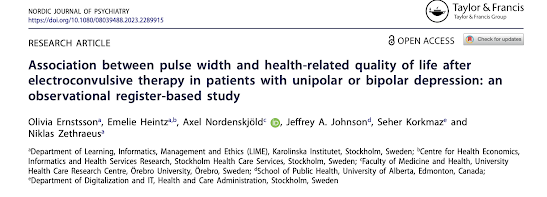ECT Pulsewidth and Quality of Life: New Register Study From Sweden
Out on PubMed, from Swedish and Canadian investigators, is this study:
Association between pulse width and health-related quality of life after electroconvulsive therapy in patients with unipolar or bipolar depression: an observational register-based study.Nord J Psychiatry. 2023 Dec 11:1-9. doi: 10.1080/08039488.2023.2289915. Online ahead of print.
PMID: 38079191
The abstract is copied below:
Aims: To examine the association between pulse width and HRQoL measured within one week after electroconvulsive therapy (ECT) and at six-month follow-up in patients with unipolar or bipolar depression.
Methods: This was an observational register study using data from the Swedish National Quality Registry for ECT (2011-2019). Inclusion criteria were: age ≥18 years; index treatment for unipolar/bipolar depression; unilateral electrode placement; information on pulse width; EQ-5D measurements before and after ECT. Multiple linear regressions were performed to investigate the association between pulse width (<0.5 ms; 0.5 ms; >0.5 ms) and HRQoL (EQ-5D-3L index; EQ VAS) one week after ECT (primary outcome) and six months after ECT (secondary outcome).
Results: The sample included 5,046 patients with unipolar (82%) or bipolar (18%) depression. At first ECT session, 741 patients (14.7%) had pulse width <0.5 ms, 3,639 (72.1%) had 0.5 ms, and 666 (13.2%) had >0.5 ms. There were no statistically significant associations between pulse width and HRQoL one week after ECT. In the subsample of patients with an EQ-5D index recorded six months after ECT (n = 730), patients receiving 0.5 ms had significantly lower HRQoL (-0.089) compared to <0.5 ms, after adjusting for demographic and clinical characteristics (p = .011). The corresponding analysis for EQ VAS did not show any statistically significant associations.
Conclusion: No robust associations were observed between pulse width and HRQoL after ECT. On average, significant improvements in HRQoL were observed one week and six months after ECT for patients with unipolar or bipolar disease, independent of the pulse width received.
Keywords: Depressive disorders; electroconvulsive therapy; eq-5d; pulse width; quality of life.
The paper is here.
And from the text:
This one is less conclusive than most of the others because the hypothesis bundles antidepressant effectiveness and adverse tolerability effects (opposites for quality of life (QOL)) together. And it may be a bit of a stretch to think that one technical parameter of ECT would have clear downstream impacts on a broad measure of outcome like QOL. Add to that the limitations of the data (including only knowing the pulsewidth at the first treatment in the series) and the lack of robust association is not at all surprising. But big data from population databases are always interesting, and there are many useful findings here, not the least of which is the confirmation of large increases in QOL from ECT overall.
Once again, kudos to Axel and colleagues for sharing the wealth of the Swedish Q-ECT.







Comments
Post a Comment